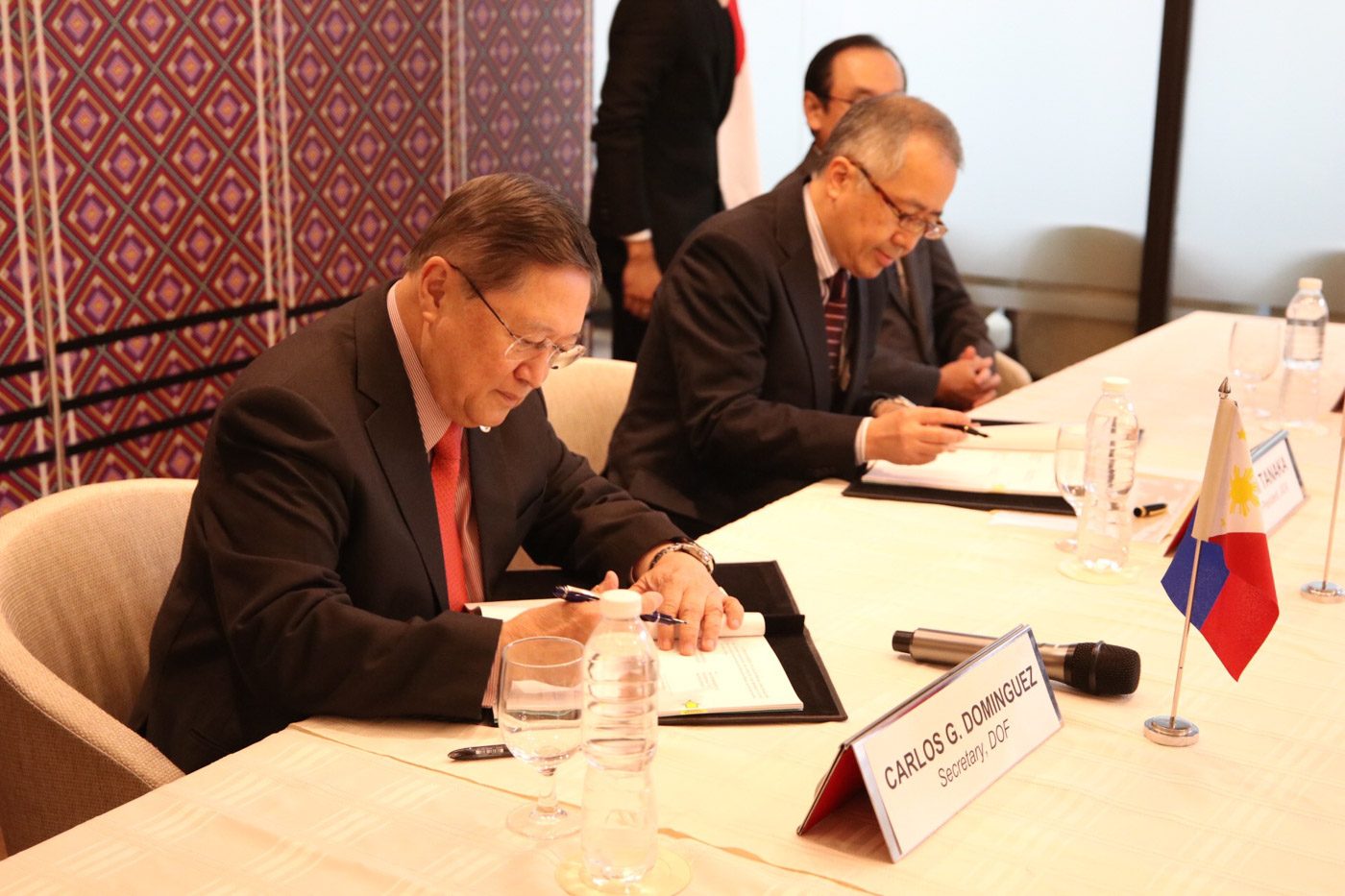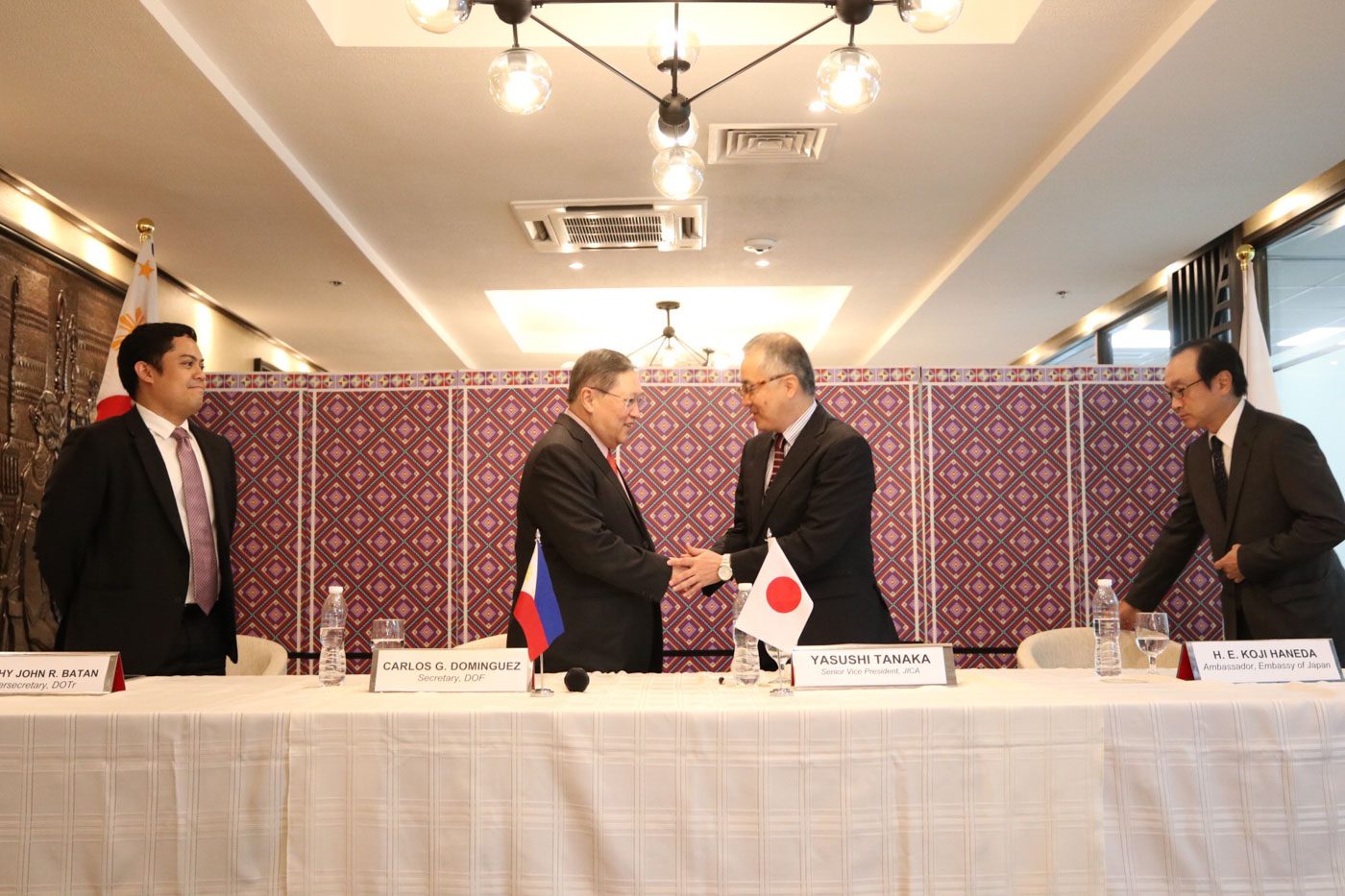SUMMARY
This is AI generated summarization, which may have errors. For context, always refer to the full article.

MANILA, Philippines (UPDATED) – The Philippines and Japan deepened their infrastructure partnership with the signing of the much-awaited P18-billion loan deal for the rehabilitation of the Metro Rail Transit Line 3 (MRT3).
On Thursday, November 8, Finance Secretary Carlos Dominguez III and Japan International Cooperation Agency (JICA) Senior Vice President Yasushi Tanaka signed the loan deal at the Department of Finance.
It was witnessed by Japanese Ambassador to the Philippines Koji Haneda, Railways Undersecretary Timothy John Batan, and other transportation officials.
With the signing of the loan agreement, Dominguez said the government would finally be able to address the “problem that is the MRT3.”
“Over the last decade, the reliability of this rail transit system simply deteriorated to a point where the MRT3 actually operated buses to move the passenger load,” Dominguez said.
“Over the past years, the MRT3 operated with less trains that were running slower, carrying less people, and suffering intermittent breakdowns to the point of becoming the symbol of where our country fails,” he added.
Tanaka said the deal is “good news for Filipino commuters” and would help the Philippine government “reduce traffic congestion in Metro Manila, attract investments, and improve the quality of life of the people.”
‘Fastest loan processing’
Back in August, the National Economic and Development Authority (NEDA) Board Investment Coordination Committee-Cabinet Committee (ICC-CabCom) approved the P22.06-billion MRT3 rehabilitation project.
It is 80% funded by the Japanese loan, while the remaining amount will be shouldered by the Philippine government.
Dominguez said the loan agreement is, by far, “the fastest loan processing” the government has completed.
The loan has a maturity period of 40 years, with a 12-year grace period. Non-consulting services under the agreement have an interest rate of 10 basis points per annum, and 1 basis point per annum for consulting services.
“This is a very soft loan that will enable us to address a very pressing problem. We recognize the urgency of the problems this rail system created. Because of that, we expeditiously acted on this loan agreement,” Dominguez said.

Rehabilitation
Ahead of the loan deal signing, Japan’s Sumitomo-Mitsubishi Heavy Industries (MHI) already returned as maintenance provider in October. Sumitomo-MHI is the original builder of the MRT3 railway system and maintained it until 2012.
Batan said that while the transition to Sumitomo-MHI as the maintenance provider has already started, full operations will start in January 2019.
Rehabilitation works would include the replacement of MRT3 tracks, the general overhaul of 72 light rail vehicles, and the repair of the power supply system, overhead catenary system, CCTV system, radio and public address system, signaling system, road-rail vehicles, depot equipment, elevators and escalators, and other station building equipment.
Even when repairs get underway, Batan said they will not reduce the capacity of the MRT3.
Two years from now, commuters may expect 20 operational trains running 60 kilometers per hour, 3.5 minutes apart.
The MRT3 problem
In 2017, the MRT3 had an average daily ridership of 463,000 from 20 running trains.
But a notice from the Department of Transportation in October 2017 showed that then-maintenance provider Busan Universal Rail Incorporated (BURI) poorly maintained the trains, and failed to put into operation reliable and efficient trains.
In November 2017, the number of trains was adjusted to 15 to ensure the safety of passengers after alleged anomalies with BURI. The contract with the maintenance provider was also terminated. (READ: Surviving MRT3: Worst train fails in 2017)
The MRT3 recorded a total of 516 glitches throughout 2017 – almost 10 incidents a week. (READ: MRT woes: How often do they happen?)
While waiting for the comeback of Sumitomo-MHI, the MRT3 maintenance transition team took over. JICA conducted an audit of the railway system in February 2018.
The MRT3 has experienced 66 breakdown incidents this year, and a record low of 6 running trains back in February. – Rappler.com
Add a comment
How does this make you feel?
There are no comments yet. Add your comment to start the conversation.